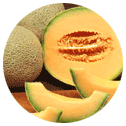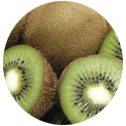 Full List of Fruits
Full List of Fruits  Yangmei fruit
Yangmei fruitYangmei fruit
Scientific name - Myrica rubra
Myrica rubra commonly known as Yangmei is also identified by several other regional names like Chinese bayberry, Japanese bayberry, Red bayberry, Waxberry and Yumberry; this tree is mainly grown for its sweet, crimson to dark purple-red edible fruit. It is a subtropical, small to medium sized tree that grows up to 10-20 m (33-66 ft) high. Having a very smooth bark that is gray in color, it has an identical spherical to hemispherical crown. With separate male and female plants, it comes under the category of dioecious. Tolerating poor acidic soils, with no apparent taproot, the root system is 5-60 cm (2.0-23.6 in) deep.
Fruit:
With a crooked surface, the fruit is spherical and it is 1.5-2.5 cm (0.59-0.98 in) in diameter. With regards to color, it is typically a deep, brilliant red, but may be different from white to purple. At the core is a single seed, with a diameter about half that of the whole fruit. With the flesh having the similar color to surface or somewhat lighter, they are sweet and very tart to taste.
![]() Nutritional Value of Yangmei fruit
Nutritional Value of Yangmei fruit
| Moisture | 89.08 |
| Vitamin A | 7 |
| Protein | 0.72 |
| Vitamin B1 | 0.01 |
| Fat | 0.31 |
| Vitamin B2 | 0.05 |
| Total carbohydrate | 6.80 |
| Vitamin B6 | 0.05 |
| Reduced sugar | 2.78 |
| Vitamin E | 0.81 |
| Total acid | 2.15 |
| Vitamin C | 9 |
| Calcium | 14 |
| Biotin | 19 |
| Phosphor | 8 |
| Carotin | 0.04 |
| Iron | 1 |
| Folacin | 26 |
| Potassium | 149 |
| Pantothenic acid | 0.3 |
| Sodium | 0.7 |
| Nicotinic acid) | 0.3 |
| Copper | 0.02 |
| Thiamine | 10 |
| Magnesium | 10 |
| Lactoflavin | 50 |
| Zinc | 0.14 |
| Dietary fiber | 1 |
| Selenium | 0.31 |
![]() Health benefits of Yangmei fruit
Health benefits of Yangmei fruit
Myrica rubra has been used by Chinese health practitioners for centuries to treat several ailments of the body. Following are some of the health benefits:
 Protects your heart health
Protects your heart health
 Good for eyesight and reduces cataracts risk
Good for eyesight and reduces cataracts risk
 Reduces your blood pressure LDL- lower bad cholesterol
Reduces your blood pressure LDL- lower bad cholesterol
 Fights inflammation
Fights inflammation
 Fortifies your cell membranes
Fortifies your cell membranes
 Cleanses stomach and intestines
Cleanses stomach and intestines
 Quenches thirst and effective to cure diarrhea
Quenches thirst and effective to cure diarrhea
 Boosts the immune system
Boosts the immune system
The benefits of Yumberry is not confined to the above said things, but it also help strengthens the elasticity of blood vessels while slowing down the collapse of collagen which in turn helps in keeping your skin smooth, firm and wrinkle-free. With all that said, the leaves, bark together with the fruit has been used as an astringent, antidote and anti-diarrhetic in traditional Chinese medication.
The Yumberry thrives in moist soil and prefers an open position either in sun or light shade. It also grows well in ordinary garden soil like lime-free loamy or peaty soil. With very less tolerance capacity to frosts, plants in this species are particularly resistant to honey fungus and have a symbiotic relationship with some soil micro-organisms. The area in which the tree is cultivated has been extended considerably because of the delicious fruit it bears out together with the health benefits exercised. As a matter of fact, they are produced more in china and also introduced in Australia.
Yangmei trees can be grown in a variety of soils, but prefer well-drained, sandy loam with plenty of organic matter. They require full sun and moderate to heavy water in summer months. Trees should be planted in the spring and pruned regularly to maintain shape and control size.
Fruiting usually begins in the third year after planting and continues for several years. Fruits should be harvested when they are fully ripe, usually in late summer or early fall. The fruits should be picked by hand and stored in cool conditions.
Yangmei trees require minimal maintenance, but should be fertilized and mulched each year to help promote growth and health. They are also susceptible to pests and disease, so regular monitoring and pest control are important.
Yangmei fruit is a valuable food source and can be a great addition to any landscape. With proper care and maintenance, yangmei trees can provide years of delicious fruit for you and your family.
Propagation of Yangmei fruit is done either by seed or vegetative methods. Seeds can be collected from the mature fruits, washed, and then dried in the sun for a few days. They should then be stored in a cool, dry place. For vegetative propagation, stem cuttings can be taken from the tree in late spring. The cuttings should be planted in a well-draining, sandy soil and kept in a warm, humid environment until they start to grow.
Yangmei trees are relatively easy to propagate and can be found in many nurseries. Once established, Yangmei trees need minimal care and can produce fruit for many years. They prefer full sun and need regular watering during the summer months. Pruning should be done in the winter to promote new growth.
Yangmei fruits are high in vitamin C and are often eaten fresh or used to make jams, jellies, and other preserves. They can also be dried and used as a tea. The leaves are used in traditional Chinese medicine to treat a variety of ailments.
Overall, Yangmei fruit is a valuable addition to any garden and can be easily propagated by either seed or vegetative methods. Once established, it requires minimal care and can produce abundant, delicious fruit for many years.
The seeds are best sown in a cold frame, as soon as it is ripe in the autumn. It is highly recommended to cover the seeds barely and keep it moist. Given a three month cold stratification, stored seed germinates more freely, when they are large enough to handle, it is good to prick out the seedlings into separate pots and grow on in the cold frame for the first winter. Having said that, to plant out in late spring or early summer is a good idea as well.


















